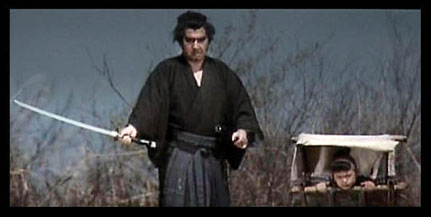|
|
Chapter Two: Shogun AssassinBy Brett BeachJune 10, 2010
Shogun Assassin is a 1980 film that “Americanizes” and edits together the first two installments in the 1970s Japanese samurai series Lone Wolf and Cub (six films released between 1972 and 1974). These films were themselves inspired by a manga of the same name that started and ran through much of that decade. There was also a television show that ran concurrently in Japan for three seasons. The six films sport such testosterone-pounding (English) subtitles as Sword of Vengeance, Baby Cart to Hades, and White Heaven in Hell. And so, Shogun Assassin pulls about 12 minutes from Sword of Vengeance (whose running time is 83 minutes) and just over 70 minutes from the second film in the series, Baby Cart at the River Styx (81 minutes) and edits them together into a single feature clocking in at 85 minutes with credits. I figured it would be beneficial to see both of the originals at the same time as I re-watched Shogun Assassin but was only able to rent the former. Most of the footage used from that film is from the earliest scenes and is employed in a similar manner in Shogun Assassin: to set the stage for our hero, Ogami Itto, as he is framed for disloyalty to his master, sees his wife murdered, and becomes a wandering ronin (master less samurai) accompanied only by his young son, Daigoro. The key differences between Shogun Assassin and its forbears - and they are quite key - are that a new musical soundtrack has been added, the speaking voices have been dubbed, and voice-over narration has been added, in the form of a fairly consistent running commentary by Daigoro. (We never hear him speak otherwise.) Let’s consider each of these in turn and how Shogun Assassin is aided, or not, by these changes.
|

|
|
|

|
Friday, November 1, 2024
© 2024 Box Office Prophets, a division of One Of Us, Inc.


